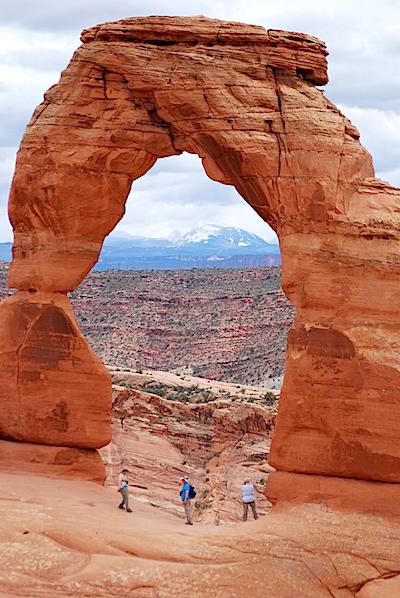
Limited parking will be available at the Delicate Arch/Wolfe Ranch parking area in Arches National Park from March through April/Kurt Repanshek
There will be limited parking at Delicate Arch in Arches National Park beginning in March and running through April as work begins to expand the parking lot.
The decision to enlarge the parking area was made in response to overcrowding and parking on the shoulders of the road leading to the Delicate Arch/Wolfe Ranch parking area. Phase two of the project will take place in June or July over approximately one week and focus on paving and striping of the expanded parking area.
The trailhead will remain open with limited parking Monday through Thursday and be fully open Friday, Saturday, and Sunday.
Expansion of this parking lot is the first step in implementation of planned congestion-management strategies outlined in the Delicate Arch/Wolfe Ranch Site Plan.
Under the expansion plan, nearly 2,000 visitors a day will be able to access Delicate Arch and the Wolfe Ranch via the parking area, according to planners. But since the expansion plan is envisioned only to accommodate traffic that currently parks along the road, park officials don't expect an overall increase in the foot traffic to Delicate Arch.
Implementation of a reservation system will only occur as a separate future planning effort, one in which the NPS will engage with partners, agencies, and the public in determining the best way to design and implement such a system.
While parks such as Acadia, Zion, Bryce Canyon and Rocky Mountain have turned to shuttle bus systems to help manage traffic and congestion, the staff at Arches concluded that that was not a reasonable solution for their park.

The cabin at Wolfe Ranch shows how hardy early homesteaders in the area were/Kurt Repanshek



Comments
When we were at Delicate arch last year it wasn't very crowded--in fact when we hiked to the arch we were the only ones there for about an hour( I hear that's very unusual) Despite that we had trouble finding a place to park-- the few spots where taken by people on the way back. As I recall it did look like a sensitive landscape with a small beautiful creek and grass growing along the shoulder of the road. Then you have the cabin and pictographs. I wonder where they plan to expand the parking-- I don't recall much room to really expand. Maybe some kind of shuttle from a remote but close lot would be better?
No Alfred, i would not shoot him for just being in the house. He would have to be an actual threat for me to pull the trigger. Thanks for the great analogy.
We can put a man on the moon but can't protect our parks. Why? Maybe because until recently, NASA has been pretty much a stand alone agency that has not had to contend with a whole lot of political and commercial interference.
Now, however, politics has wormed its way into NASA's work and look what's happening to our space program.
Maybe we need a challenge to "protect our parks and our public lands and environment by the end of this decade" and a surge of national committment like we had back in the days of Mercury and Apollo.
We had a unified vision of going to the moon. Your version of "protecting" the parks is quite different than others. It isn't necessarily wrong but it certainly isn't universal.
Exactly. And there wasn't a big profit motive for some in reaching the moon as there is in exploiting our park resources.
Oh, there was plenty of profit incentive in that project. We spent over $20 billion in 1969 dollars ($130 billion in today's dollars) just on the Apollo missions. That's 45 years of NPS spending.
Normal
0
false
false
false
EN-US
X-NONE
X-NONE
/* Style Definitions */
table.MsoNormalTable
{mso-style-name:"Table Normal";
mso-tstyle-rowband-size:0;
mso-tstyle-colband-size:0;
mso-style-noshow:yes;
mso-style-priority:99;
mso-style-parent:"";
mso-padding-alt:0in 5.4pt 0in 5.4pt;
mso-para-margin-top:0in;
mso-para-margin-right:0in;
mso-para-margin-bottom:8.0pt;
mso-para-margin-left:0in;
line-height:107%;
mso-pagination:widow-orphan;
font-size:11.0pt;
font-family:"Calibri",sans-serif;
mso-ascii-font-family:Calibri;
mso-ascii-theme-font:minor-latin;
mso-hansi-font-family:Calibri;
mso-hansi-theme-font:minor-latin;
mso-bidi-font-family:"Times New Roman";
mso-bidi-theme-font:minor-bidi;}